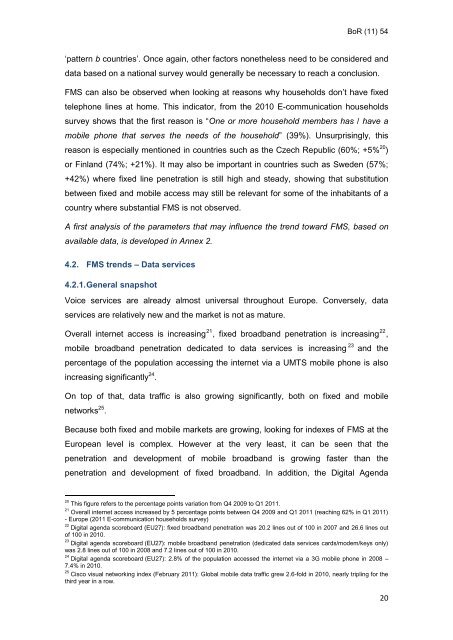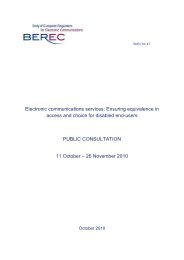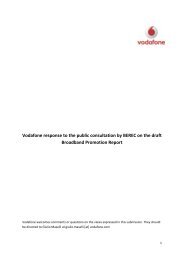BEREC REPORT ON IMPACT OF FIXED-MOBILE ... - berec - Europa
BEREC REPORT ON IMPACT OF FIXED-MOBILE ... - berec - Europa
BEREC REPORT ON IMPACT OF FIXED-MOBILE ... - berec - Europa
Create successful ePaper yourself
Turn your PDF publications into a flip-book with our unique Google optimized e-Paper software.
BoR (11) 54<br />
‘pattern b countries’. Once again, other factors nonetheless need to be considered and<br />
data based on a national survey would generally be necessary to reach a conclusion.<br />
FMS can also be observed when looking at reasons why households don’t have fixed<br />
telephone lines at home. This indicator, from the 2010 E-communication households<br />
survey shows that the first reason is “One or more household members has / have a<br />
mobile phone that serves the needs of the household” (39%). Unsurprisingly, this<br />
reason is especially mentioned in countries such as the Czech Republic (60%; +5% 20 )<br />
or Finland (74%; +21%). It may also be important in countries such as Sweden (57%;<br />
+42%) where fixed line penetration is still high and steady, showing that substitution<br />
between fixed and mobile access may still be relevant for some of the inhabitants of a<br />
country where substantial FMS is not observed.<br />
A first analysis of the parameters that may influence the trend toward FMS, based on<br />
available data, is developed in Annex 2.<br />
4.2. FMS trends – Data services<br />
4.2.1. General snapshot<br />
Voice services are already almost universal throughout Europe. Conversely, data<br />
services are relatively new and the market is not as mature.<br />
Overall internet access is increasing 21 , fixed broadband penetration is increasing 22 ,<br />
mobile broadband penetration dedicated to data services is increasing 23 and the<br />
percentage of the population accessing the internet via a UMTS mobile phone is also<br />
increasing significantly 24 .<br />
On top of that, data traffic is also growing significantly, both on fixed and mobile<br />
networks 25 .<br />
Because both fixed and mobile markets are growing, looking for indexes of FMS at the<br />
European level is complex. However at the very least, it can be seen that the<br />
penetration and development of mobile broadband is growing faster than the<br />
penetration and development of fixed broadband. In addition, the Digital Agenda<br />
20 This figure refers to the percentage points variation from Q4 2009 to Q1 2011.<br />
21 Overall internet access increased by 5 percentage points between Q4 2009 and Q1 2011 (reaching 62% in Q1 2011)<br />
- Europe (2011 E-communication households survey)<br />
22 Digital agenda scoreboard (EU27): fixed broadband penetration was 20.2 lines out of 100 in 2007 and 26.6 lines out<br />
of 100 in 2010.<br />
23 Digital agenda scoreboard (EU27): mobile broadband penetration (dedicated data services cards/modem/keys only)<br />
was 2.8 lines out of 100 in 2008 and 7.2 lines out of 100 in 2010.<br />
24 Digital agenda scoreboard (EU27): 2.8% of the population accessed the internet via a 3G mobile phone in 2008 –<br />
7.4% in 2010.<br />
25 Cisco visual networking index (February 2011): Global mobile data traffic grew 2.6-fold in 2010, nearly tripling for the<br />
third year in a row.<br />
20





